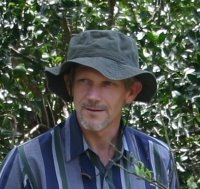A couple of weekends ago Nathanael and I made our way west from Mbale to Lake Mburo National Park, and then on to Mbarara town and back to Mbale with an overnight stop in Entebbe. Mburo is less welll-known (and less frequented) than the "major" wildlife sanctuaries in Uganda -- Queen Elizabeth, Murchison, and Kidepo -- but it has a number of distinctions, such as being the only protected area in Uganda that contains one or more lakes in their entirety.
We enjoyed excellent views of most of the park's main animal species, including zebra, impala, buffalo, oribi, defassa waterbuck, bushbuck, eland, topi, warthog, hippo, crocodile, and three species of mongoose.
Of course the birds were a treat, and herewith some highlights:
* Common squacco heron (Ardeola ralloides)
* Rufous-bellied heron (Ardeola rufiventris)
* Black-crowned night-heron (Nycticorax nyticorax)
* White-backed night-heron (Gorsachius leuconotos) -- These are secretive and seldom seen, even where they are resident, and my first sighting of them (a pair, alongside a couple of black-crowned night-herons).
* Saddle-billed stork (Ephippiorhynchus senegalensis) -- a pair in the shallows of Lake Victoria at Entebbe; eventually they were put to flight by someone's retriever that had great fun splashing after them for a hundred meters or so
* Glossy ibis (Plegadis falcinellus) -- Entebbe
* African finfoot (Podica senegalensis) -- In some ways this uncommon bird with bright red beak and feet is the most noteworthy member on our trip list, and especially so for me since I'd not seen them before. They require an aquatic habitat with overhanging vegetation, which makes them hard to see even where they do occur. I had hoped to see even one, and we were blessed to see several on two different days there.
* Long-toed lapwing (Vanellus crassirostris)
* African wattled lapwing (Vanellus senegallus)
* Yellow-billed stork (Mycteria ibis)
* Wooly-necked stork (Ciconia episcopus)
* Glossy ibis (Plegadis falcinellis) -- Entebbe
* Egyptian goose (Alopochen aegyptiacus)
* Spur-winged goose (Plectropterus gambensis)
* African fish eagle (Haliaeetus vocifer)
* African white-backed vulture (Gyps africanus), Ruepell's Griffon Vulture (Gyps rueppellii), Lappet-faced vulture (Torgos tracheliotus) -- We came across a mixed multitude of these scavengers, along with a tawny eagle (Aquila rapax) and a marabou (Leptoptilos crumeniferus), giving ravenous attention to a zebra carcass.
* Brown snake eagle (Circaetus cinereus) -- Saw three of these, one of them on a nest
* African marsh harrier (Circus ranivorus)
* Gabar goshawk (Micronisus gabar) -- an adult and immature at Entebbe
* African harrier hawk (Polyboroides typus) -- Mbarara
* Wahlberg's eagle (Aquila wahlbergi)
* Bateleur (Terathopius ecaudatus)
* Long-crested eagle (Lophaetus occipitalis)
* Black-shouldered kite (Elanus caeruleus)
* Grey Kestrel (Falco ardosiaceus) -- Entebbe
* Helmeted guineafowl (Numida meleagris)
* Crested francolin (Francolinus sephaena)
* Red-necked spurfowl (Francolinus afer)
* Black crake (Amaurornis flavirostris)
* African jacana (Actophilornis africanus)
* Grey crowned crane (Balearica regulorum)
* Black-bellied bustard (Eupodotis melanogaster)
* Water thick-knee (Burhinus vermiculatus)
* Emerald-spotted wood-dove (Turtur chalcospilos)
* Red-headed lovebird (Agapornis pullarius)
* Ross's turaco (Musophaga rossae)
* Bare-faced go-away-bird (Corythaixoides personata)
* White-rumped swift (Apus caffer)
* Blue-naped mousebird (Urocolius macrourus)
* Giant kingfisher (Megaceryle maxima)
* Malachite kingfisher (Alcedo cristata), African pygmy kingfisher (Ispidina picta) -- Unusually, saw both of these species on the same bit of lakeshore. Malachite is always tied closely to water, but the pygmy has no necessary connection to it.
* Little bee-eater (Merops pusillus)
* Madagascar bee-eater (Merops superciliosus) -- Entebbe
* Lilac-breasted roller (Coracias caudata)
* Green wood-hoopoe (Phoeniculus purpureus)
* African grey hornbill (Tockus nasutus)
* Crowned hornbill (Tockus alboterminatus)
* Spot-flanked barbet (Tricholaema lachrymosa)
* Red-faced barbet (Lybius rubrifacies) -- A bird of very limited distribution (one of the "East African endemics"), this attractive barbet is perhaps even more sought-after by birders than the finfoot. We had a splendid view of one bird, another first for me.
* Double-toothed barbet (Lybius bidentatus) -- Mbarara, Entebbe
* Mosque swallow (Hirundo senegalensis)
* Yellow-throated longclaw (Macronyx croceus)
* Sooty chat (Myrmecocichla nigra)
* Trilling cisticola (Cisticola woosnami)
* Grey-capped warbler (Eminia lepida)
* Yellow-breasted apalis (Apalis flavida)
* Chin-spot batis (Batis molitor)
* Brown-throated wattle-eye (Platysteira cyanea)
* African paradise-flycatcher (Terpsiphone viridis)
* Black-lored babbler (Turdoides sharpei)
* White-winged tit (Parus leucomelas)
* Grey-backed fiscal (Lanius excubitoroides)
* Fork-tailed drongo (Dicrurus adsimilis)
* Yellow-billed oxpecker (Buphagus africanus)
* Holub's golden weaver (Ploceus xanthops)
* Yellow-backed weaver (Ploceus melanocephalus) -- Entebbe
* African golden-breasted bunting (Emberiza flaviventris)
